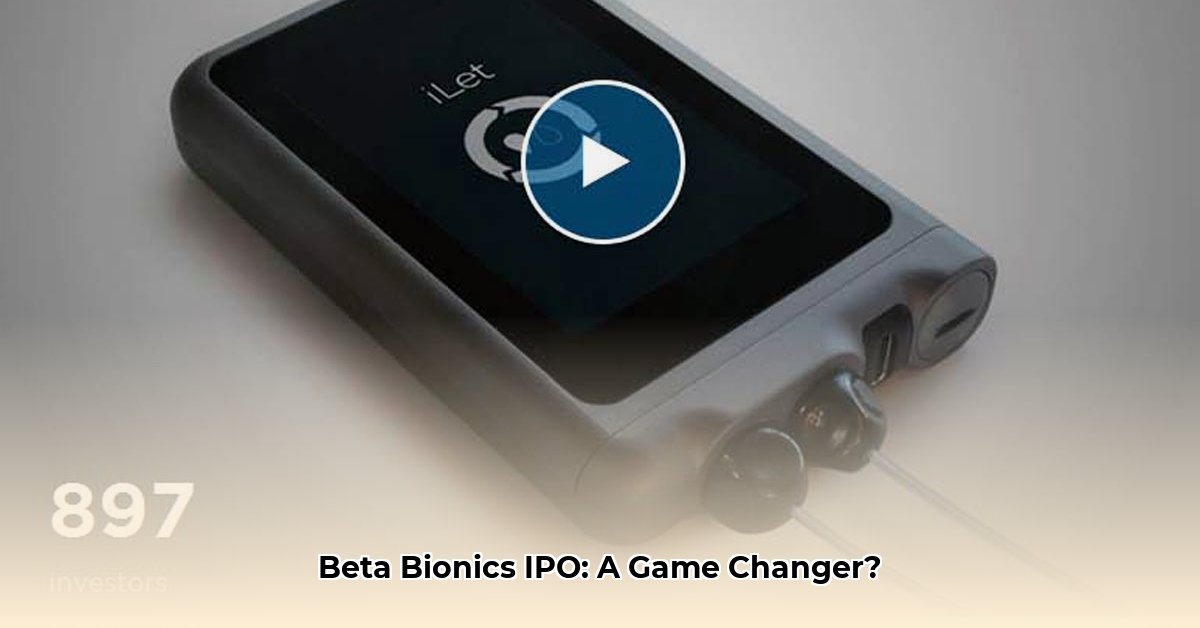
Beta Bionics' $229 Million IPO: A Deep Dive into the iLet's Future
Beta Bionics, the developer of the innovative iLet bionic pancreas, recently completed its initial public offering (IPO), raising $229 million. This significant funding round signals strong investor confidence in the revolutionary device, but a closer examination reveals a more complex picture. While the capital infusion is substantial, a considerable portion stemmed from existing investors selling shares, rather than entirely fresh investment. This raises questions about the true market sentiment and the long-term financial trajectory of the company. Will this be a catalyst for explosive growth, or a precursor to future challenges?
The iLet, an automated insulin delivery system approved by the FDA in May 2023, represents a paradigm shift in diabetes management. Its seamless integration with Abbott's FreeStyle Libre 3 Plus simplifies the process, significantly improving the daily lives of countless individuals. But Beta Bionics isn't alone in this burgeoning market. Competitors like Insulet, Tandem, and Medtronic are fiercely vying for market share with similar technologies. The success of Beta Bionics hinges on its ability to differentiate the iLet and effectively navigate both the clinical and financial aspects of a highly competitive landscape. Is the iLet truly poised to dominate, or is its success predicated on a highly optimistic outlook?
The IPO proceeds, while substantial, didn't trigger a dramatic surge in the share price, leaving some investors cautiously optimistic. The initial offering price of $17 per share remained relatively stagnant. This suggests a degree of apprehension within the investment community, perhaps mirroring concerns regarding the company's long-term financial stability. Can Beta Bionics successfully navigate the challenges ahead and translate its technological innovation into sustained financial success? The answer isn't self-evident.
Key Factors Influencing Beta Bionics' Long-Term Viability
Beta Bionics has outlined a comprehensive strategy encompassing both short-term and long-term objectives. Their success hinges critically on the effective execution of this detailed plan.
Short-Term Goals (Next Year):
- Aggressive marketing and sales campaigns for widespread iLet adoption.
- Accelerated development of the bihormonal iLet, offering enhanced diabetes management capabilities.
- Strategic alliances with key players in the healthcare industry to bolster market penetration.
Long-Term Goals (Next 3-5 Years):
- Establish market leadership in automated insulin delivery systems.
- Expand the product portfolio to offer diversified solutions for diabetes management.
- Global market expansion, bringing the iLet to patients worldwide.
The Beta Bionics IPO impacts a wide range of stakeholders, each with their own priorities.
| Stakeholder | Short-Term Priorities | Long-Term Aspirations |
|---|---|---|
| Beta Bionics | Maximize iLet sales, establish key partnerships, expedite bihormonal iLet development | Secure market leadership, diversify product offerings, achieve global reach |
| Investors | Strong financial performance, competitive advantage, sustained growth | Long-term profitability, regulatory compliance, minimized risks |
| Patients & Doctors | Easy access to the iLet, comprehensive training, seamless system integration | Improved patient outcomes, widespread adoption of advanced technology, personalized treatment plans |
| FDA & Regulators | Verification of iLet safety and efficacy, rigorous review of future submissions | Approval of cutting-edge technology, streamlined regulatory pathways for future innovations |
Navigating the Challenges: Risk Assessment and Mitigation
Beta Bionics faces a series of significant challenges, each requiring careful consideration and proactive mitigation strategies.
| Risk Factor | Likelihood | Impact | Strategies to Minimize Risk |
|---|---|---|---|
| Intense Competition | High | High | Aggressive marketing, continuous innovation, strategic collaborations |
| Regulatory Hurdles | Medium | High | Proactive collaboration with the FDA, robust clinical trials, strict regulatory compliance |
| Financial Stability | Medium | Medium | Prudent resource allocation, securing additional funding, rigorous cost control |
| Market Acceptance | Medium | Medium | Targeted marketing campaigns, physician endorsements, user-friendly design |
How to Assess Beta Bionics' Long-Term Financial Outlook
The long-term financial viability of Beta Bionics post-IPO requires a multi-faceted assessment encompassing both clinical and market dynamics. Several key questions need to be addressed: How substantial is the actual market demand for the iLet? How effectively can Beta Bionics manage the inherent risks associated with regulatory hurdles and intense competition? Will they establish sustainable market penetration, and how will they navigate both the upfront cost and ongoing long-term maintenance costs of their advanced technology?
Key Considerations for Long-Term Viability Assessment:
- Clinical Efficacy: A thorough review of the iLet's effectiveness, going beyond initial trial data to incorporate real-world usage patterns and long-term outcomes.
- Market Analysis: Detailed market research to determine the total addressable market (TAM), penetration rate projections, and competitive analysis.
- Regulatory and Reimbursement: Assessment of the likelihood of securing FDA approval and favorable reimbursement policies from insurance providers. This involves a thorough understanding of the relevant regulatory landscape.
- Financial Projections: Development of detailed financial models encompassing sales forecasts, manufacturing costs, R&D investments, and potential revenue streams. Contingency planning should factor in various market scenarios.
- Risk Management: A comprehensive assessment of potential risks, including competitive pressures, regulatory delays, technological obsolescence, and manufacturing challenges.